towing FIAT PANDA 2009 169 / 2.G Owners Manual
[x] Cancel search | Manufacturer: FIAT, Model Year: 2009, Model line: PANDA, Model: FIAT PANDA 2009 169 / 2.GPages: 226, PDF Size: 5.29 MB
Page 114 of 226
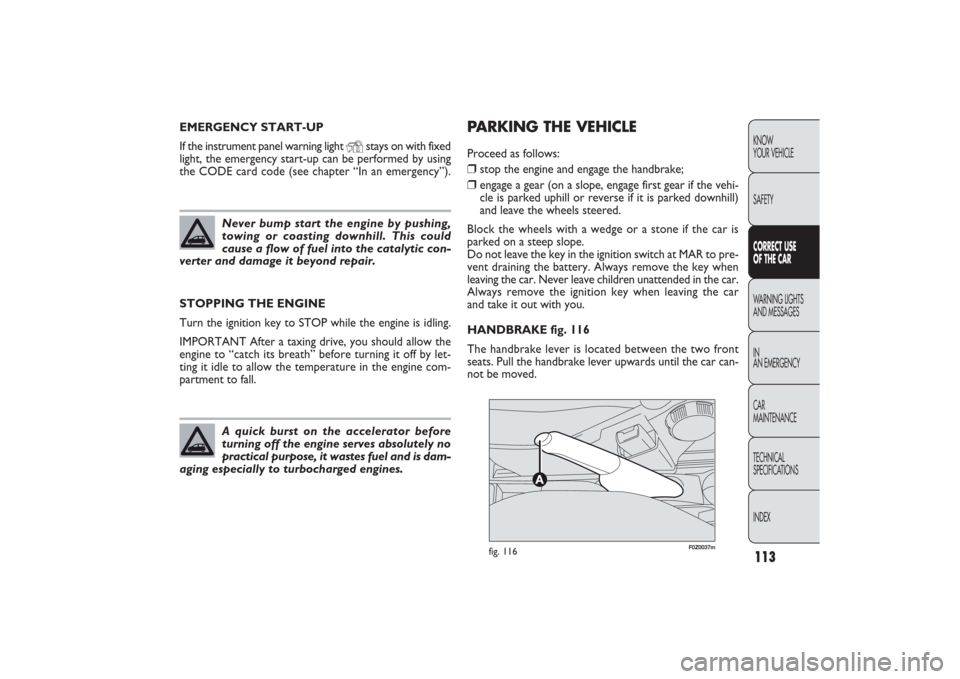
113KNOW
YOUR VEHICLE
SAFETYCORRECT USE
OF THE CARWARNING LIGHTS
AND MESSAGES
IN
AN EMERGENCY
CAR
MAINTENANCE
TECHNICAL
SPECIFICATIONS
INDEX
F0Z0037m
fig. 116
PARKING THE VEHICLEProceed as follows:❒
stop the engine and engage the handbrake;
❒
engage a gear (on a slope, engage first gear if the vehi-
cle is parked uphill or reverse if it is parked downhill)
and leave the wheels steered.
Block the wheels with a wedge or a stone if the car is
parked on a steep slope.
Do not leave the key in the ignition switch at MAR to pre-
vent draining the battery. Always remove the key when
leaving the car. Never leave children unattended in the car.
Always remove the ignition key when leaving the car
and take it out with you.
HANDBRAKE fig. 116
The handbrake lever is located between the two front
seats. Pull the handbrake lever upwards until the car can-
not be moved. STOPPING THE ENGINE
Turn the ignition key to STOP while the engine is idling.
IMPORTANT After a taxing drive, you should allow the
engine to “catch its breath” before turning it off by let-
ting it idle to allow the temperature in the engine com-
partment to fall.
Never bump start the engine by pushing,
towing or coasting downhill. This could
cause a flow of fuel into the catalytic con-
verter and damage it beyond repair.A quick burst on the accelerator before
turning off the engine serves absolutely no
practical purpose, it wastes fuel and is dam-
aging especially to turbocharged engines.
EMERGENCY START-UP
If the instrument panel warning light
Y
stays on with fixed
light, the emergency start-up can be performed by using
the CODE card code (see chapter “In an emergency”).
111-122 PANDA EN 7-10-2009 15:01 Pagina 113
Page 118 of 226

117KNOW
YOUR VEHICLE
SAFETYCORRECT USE
OF THE CARWARNING LIGHTS
AND MESSAGES
IN
AN EMERGENCY
CAR
MAINTENANCE
TECHNICAL
SPECIFICATIONS
INDEX
TOWING TRAILERSIMPORTANT NOTES
For towing caravans or trailers the car must be fitted with
a certified tow hook and an adequate electric system. In-
stallation should be carried out by specialised personnel
who will issue the required papers for travelling on roads.
Install any specific and/or additional rear view mirrors as
specified by the Highway Code.
Remember that when towing a trailer, steep hills are hard-
er to climb, braking spaces increase and overtaking takes
longer depending on the overall weight.
Engage a low gear when driving downhill, rather than con-
stantly using the brake.
The weight the trailer exerts on the car tow hook reduces
by the same amount the actual car loading capacity. To
make sure the maximum towable weight is not exceeded
(given in the car registration document) account should
be taken of the fully laden trailer, including accessories and
luggage.
Do not exceed the speed limits specific for each country
you are driving in, in case of vehicles towing trailers. In any
case, the top speed must not exceed 100 km/h. Traffic and road conditions
Rather high consumption levers are tied to situations with
heavy traffic, for instance when travelling in queues with
frequent use of the lower gears or in cities with many traf-
fic lights. Also winding mountain roads and rough road sur-
faces adversely affect consumption.
Traffic hold-ups
During prolonged hold-ups (e.g. level crossings) the engine
should be switched off.
111-122 PANDA EN 7-10-2009 15:01 Pagina 117
Page 119 of 226
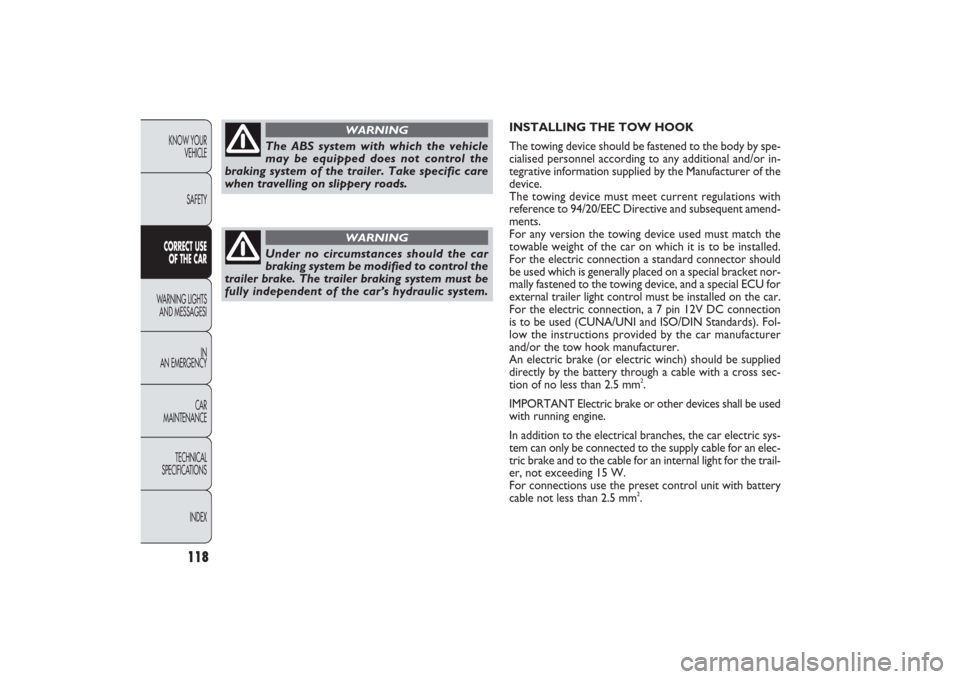
118
KNOW YOUR
VEHICLE
SAFETYCORRECT USE
OF THE CARWARNING LIGHTS
AND MESSAGESI
IN
AN EMERGENCY
CAR
MAINTENANCE
TECHNICAL
SPECIFICATIONS
INDEX
INSTALLING THE TOW HOOK
The towing device should be fastened to the body by spe-
cialised personnel according to any additional and/or in-
tegrative information supplied by the Manufacturer of the
device.
The towing device must meet current regulations with
reference to 94/20/EEC Directive and subsequent amend-
ments.
For any version the towing device used must match the
towable weight of the car on which it is to be installed.
For the electric connection a standard connector should
be used which is generally placed on a special bracket nor-
mally fastened to the towing device, and a special ECU for
external trailer light control must be installed on the car.
For the electric connection, a 7 pin 12V DC connection
is to be used (CUNA/UNI and ISO/DIN Standards). Fol-
low the instructions provided by the car manufacturer
and/or the tow hook manufacturer.
An electric brake (or electric winch) should be supplied
directly by the battery through a cable with a cross sec-
tion of no less than 2.5 mm
2.
IMPORTANT Electric brake or other devices shall be used
with running engine.
In addition to the electrical branches, the car electric sys-
tem can only be connected to the supply cable for an elec-
tric brake and to the cable for an internal light for the trail-
er, not exceeding 15 W.
For connections use the preset control unit with battery
cable not less than 2.5 mm2.
The ABS system with which the vehicle
may be equipped does not control the
braking system of the trailer. Take specific care
when travelling on slippery roads.
WARNING
Under no circumstances should the car
braking system be modified to control the
trailer brake. The trailer braking system must be
fully independent of the car’s hydraulic system.
WARNING
111-122 PANDA EN 7-10-2009 15:01 Pagina 118
Page 126 of 226

ABS SYSTEM FAILURE (amber)Turning the ignition key to
MAR
the
warning light turns on, but it should go off
after a few seconds.
The warning light will light up when the system is either
not working or not available. Under these circumstances
the braking system will work as normal without the ex-
tra performance offered by the ABS system. Drive care-
fully and contact a Fiat Dealership as soon as possible.
On some versions the display shows the dedicated message.
125KNOW
YOUR VEHICLE
SAFETY
CORRECT USE
OF THE CARWARNING LIGHTS
AND MESSAGESIN
AN EMERGENCY
CAR
MAINTENANCE
TECHNICAL
SPECIFICATIONS
INDEX
IMPORTANT Under severe use of the car, it is advisable
to keep the engine on and slightly accelerated for a few
minutes before switching it off.
On some versions the display shows the dedicated message. ENGINE COOLANT HIGH TEMPERA-
TURE (red)
Turning the ignition key to MAR the warning light
turns on, but it should go off after a few seconds. The
warning light turns on when the engine is overheated. If
the warning light comes on when driving, proceed as fol-
lows:
❒in standard normal driving conditions: stop the car,
switch off the engine and check whether the water lev-
el in the reservoir is not below the MIN. mark. In this
case, wait for a few minutes for the engine to cool
down, then slowly and carefully open the cap, top-up
with coolant and check that the level is between the
MIN. and MAX. marks on the reservoir itself. Also
check for any fluid leaks. If, when restarting, the warn-
ing light should come on again, contact a Fiat Dealer-
ship.
❒In case of car heavy duty (e.g.: towing trailer uphill or
fully laden car): decrease speed, if the warning light stays
on, stop the car. Wait for 2 or 3 minutes with the en-
gine running and slightly accelerated to further accel-
erate the coolant circulation. Then stop the engine.
Check the correct liquid level as described above.
ç
LOW BATTERY CHARGE (red)
Turning the ignition key to
MAR
, the warning
light turns on and should go out as soon as the
engine is started (with the engine running at idle speed
a short delay in going out is allowed).
If the warning light stays on contact immediately a Fiat
Dealership.
wx
>
123-134 PANDA EN 7-10-2009 13:49 Pagina 125
Page 137 of 226

136KNOW
YOUR VEHICLE
SAFETY
CORRECT USE
OF THE CAR
WARNING LIGHTS
AND MESSAGES
IN
AN EMERGENCYCAR
MAINTENANCE
TECHNICAL
SPECIFICATIONS
INDEX
Never use a fast battery-charger to start the
engine as this could damage the electron-
ic systems of your car, particularly the ig-
nition and fuel supply control units.This procedure must be performed by qual-
ified personnel as incorrect actions may
cause high-intensity electrical discharge. Further-
more, battery fluid is poisonous and corrosive: avoid
contact with your skin and eyes. Keep naked flames
away from the battery. No smoking. Do not cause
sparks.
WARNING
If after a few attempts the engine does not start, do not
insist rather contact the nearest Fiat Dealership.
IMPORTANT Do not directly connect the negative ter-
minals of the two batteries: any sparks may ignite the det-
onating gas which could come out of the battery. If the aux-
iliary battery is installed on another car, prevent any contact
between metal parts of the cars and the flat battery.
BUMP STARTING
Never bump start the engine by pushing, towing or driving
downhill.
This could cause a flow of fuel into the catalytic convert-
er and damage it beyond repair.
IMPORTANT Remember that the servo-brake and elec-
trical power steering system (for versions/markets where
provided) are not operating until the engine is started, a
greater effort will therefore be required to press the brake
pedal or turn the steering wheel. Proceed as follows to start the car:
❒
connect the positive terminals (+ sign close to the ter-
minal) of both batteries using a lead;
❒
with a second lead, connect the negative terminal − of
the auxiliary battery to an earthing point
E
on the en-
gine or the gearbox of the car to be started;
❒
start the engine;
❒
when the engine has been started, follow the sequence
above in reverse order to remove the leads.
135-168 PANDA EN 7-10-2009 14:06 Pagina 136
Page 168 of 226
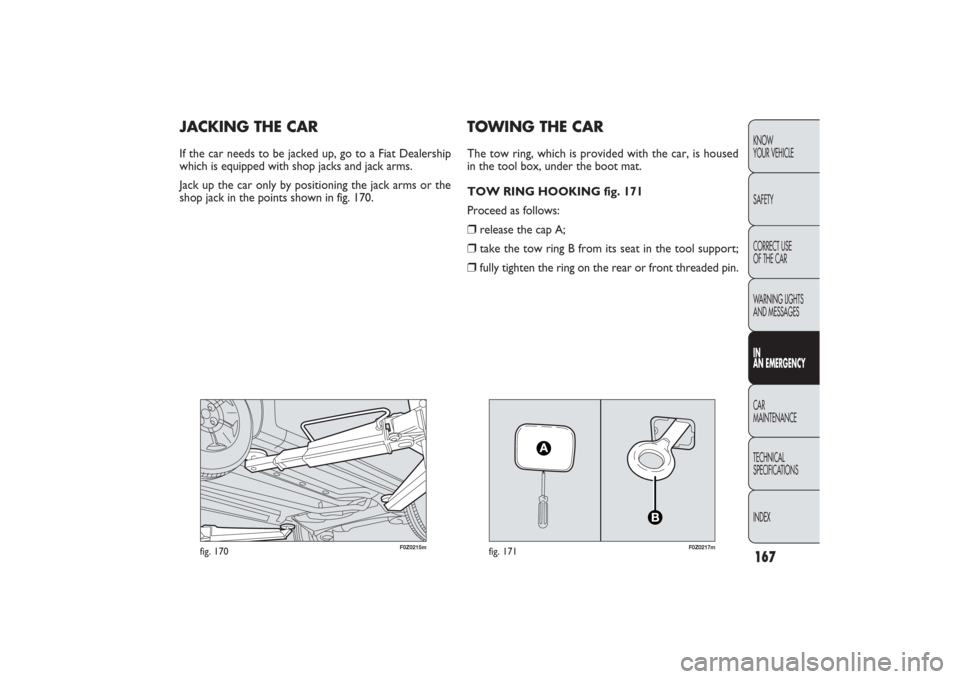
167KNOW
YOUR VEHICLE
SAFETY
CORRECT USE
OF THE CAR
WARNING LIGHTS
AND MESSAGESIN
AN EMERGENCYCAR
MAINTENANCE
TECHNICAL
SPECIFICATIONS
INDEX
F0Z0215m
fig. 170
F0Z0217m
fig. 171
TOWING THE CARThe tow ring, which is provided with the car, is housed
in the tool box, under the boot mat.
TOW RING HOOKING fig. 171
Proceed as follows:❒
release the cap A;
❒
take the tow ring B from its seat in the tool support;
❒
fully tighten the ring on the rear or front threaded pin.
JACKING THE CARIf the car needs to be jacked up, go to a Fiat Dealership
which is equipped with shop jacks and jack arms.
Jack up the car only by positioning the jack arms or the
shop jack in the points shown in fig. 170.
135-168 PANDA EN 7-10-2009 14:07 Pagina 167
Page 169 of 226
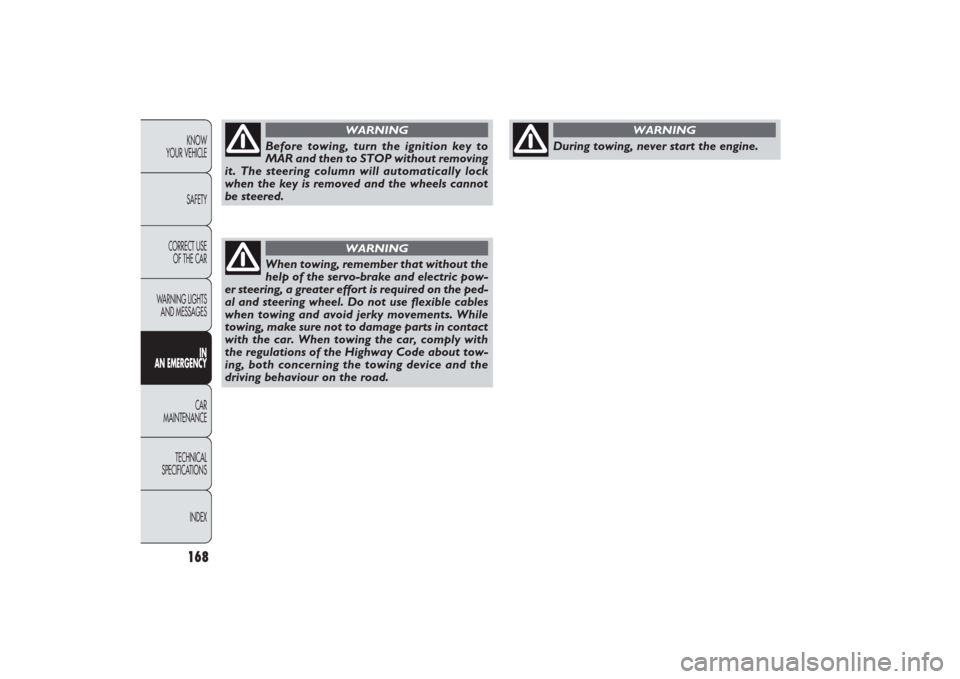
168KNOW
YOUR VEHICLE
SAFETY
CORRECT USE
OF THE CAR
WARNING LIGHTS
AND MESSAGES
IN
AN EMERGENCYCAR
MAINTENANCE
TECHNICAL
SPECIFICATIONS
INDEX
Before towing, turn the ignition key to
MAR and then to STOP without removing
it. The steering column will automatically lock
when the key is removed and the wheels cannot
be steered.
WARNING
When towing, remember that without the
help of the servo-brake and electric pow-
er steering, a greater effort is required on the ped-
al and steering wheel. Do not use flexible cables
when towing and avoid jerky movements. While
towing, make sure not to damage parts in contact
with the car. When towing the car, comply with
the regulations of the Highway Code about tow-
ing, both concerning the towing device and the
driving behaviour on the road.
WARNING
During towing, never start the engine.
WARNING
135-168 PANDA EN 7-10-2009 14:07 Pagina 168
Page 170 of 226
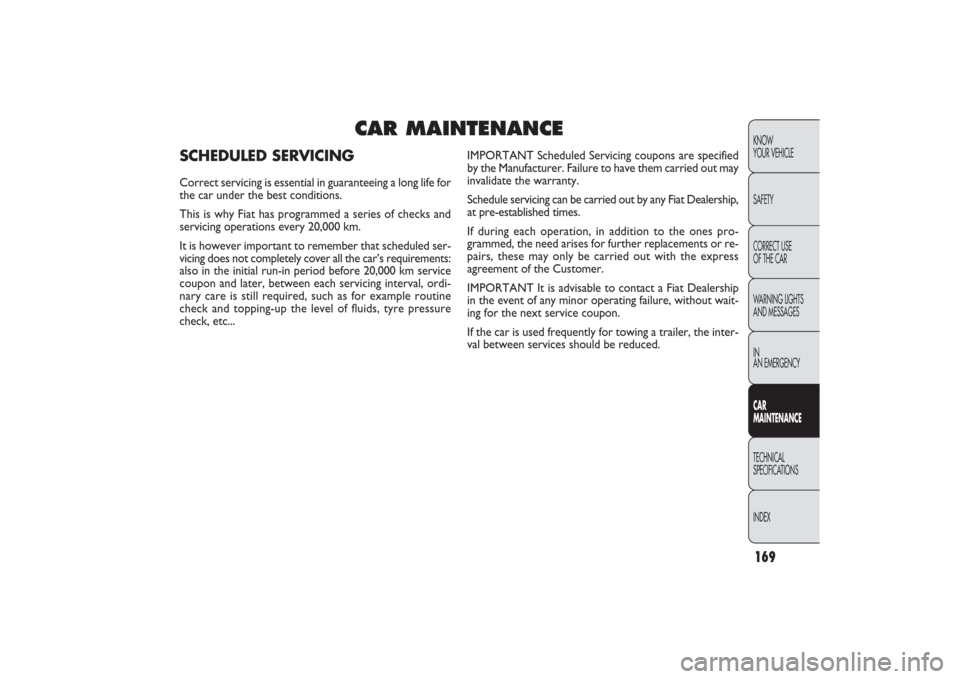
169KNOW
YOUR VEHICLE
SAFETY
WARNING LIGHTS
AND MESSAGES
IN
AN EMERGENCYCAR
MAINTENANCETECHNICAL
SPECIFICATIONS
INDEX
CAR MAINTENANCE
SCHEDULED SERVICINGCorrect servicing is essential in guaranteeing a long life for
the car under the best conditions.
This is why Fiat has programmed a series of checks and
servicing operations every 20,000 km.
It is however important to remember that scheduled ser-
vicing does not completely cover all the car’s requirements:
also in the initial run-in period before 20,000 km service
coupon and later, between each servicing interval, ordi-
nary care is still required, such as for example routine
check and topping-up the level of fluids, tyre pressure
check, etc...
CORRECT USE
OF THE CAR
IMPORTANT Scheduled Servicing coupons are specified
by the Manufacturer. Failure to have them carried out may
invalidate the warranty.
Schedule servicing can be carried out by any Fiat Dealership,
at pre-established times.
If during each operation, in addition to the ones pro-
grammed, the need arises for further replacements or re-
pairs, these may only be carried out with the express
agreement of the Customer.
IMPORTANT It is advisable to contact a Fiat Dealership
in the event of any minor operating failure, without wait-
ing for the next service coupon.
If the car is used frequently for towing a trailer, the inter-
val between services should be reduced.
169-190 PANDA EN 7-10-2009 14:14 Pagina 169
Page 173 of 226
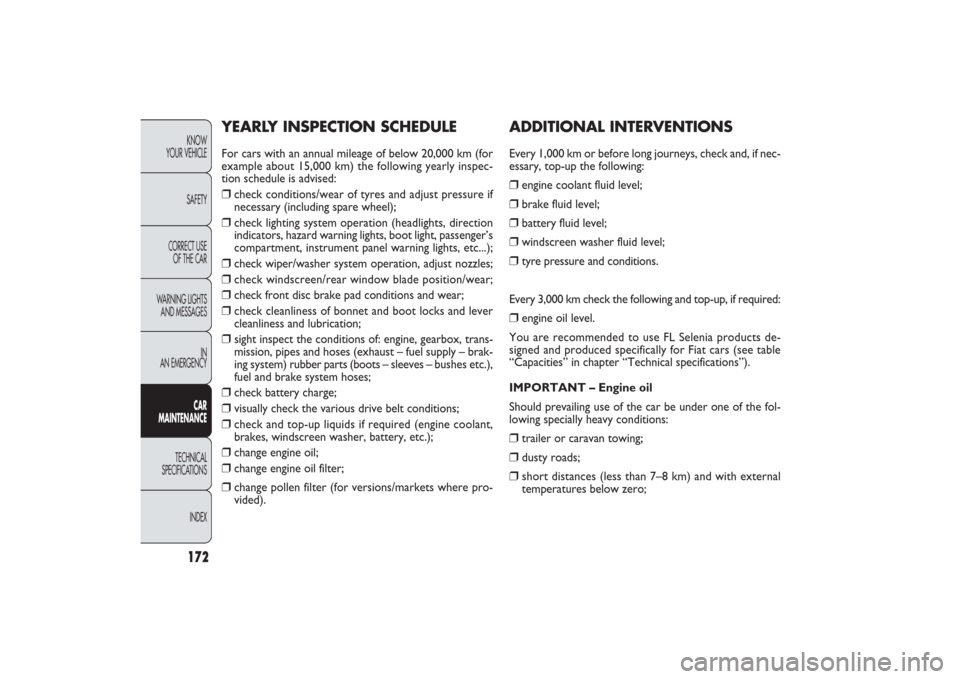
YEARLY INSPECTION SCHEDULEFor cars with an annual mileage of below 20,000 km (for
example about 15,000 km) the following yearly inspec-
tion schedule is advised:❒
check conditions/wear of tyres and adjust pressure if
necessary (including spare wheel);
❒
check lighting system operation (headlights, direction
indicators, hazard warning lights, boot light, passenger’s
compartment, instrument panel warning lights, etc...);
❒
check wiper/washer system operation, adjust nozzles;
❒
check windscreen/rear window blade position/wear;
❒
check front disc brake pad conditions and wear;
❒
check cleanliness of bonnet and boot locks and lever
cleanliness and lubrication;
❒
sight inspect the conditions of: engine, gearbox, trans-
mission, pipes and hoses (exhaust – fuel supply – brak-
ing system) rubber parts (boots – sleeves – bushes etc.),
fuel and brake system hoses;
❒
check battery charge;
❒
visually check the various drive belt conditions;
❒
check and top-up liquids if required (engine coolant,
brakes, windscreen washer, battery, etc.);
❒
change engine oil;
❒
change engine oil filter;
❒
change pollen filter (for versions/markets where pro-
vided).
ADDITIONAL INTERVENTIONSEvery 1,000 km or before long journeys, check and, if nec-
essary, top-up the following:❒
engine coolant fluid level;
❒
brake fluid level;
❒
battery fluid level;
❒
windscreen washer fluid level;
❒
tyre pressure and conditions.
Every 3,000 km check the following and top-up, if required:
❒
engine oil level.
You are recommended to use FL Selenia products de-
signed and produced specifically for Fiat cars (see table
“Capacities” in chapter “Technical specifications”).
IMPORTANT – Engine oil
Should prevailing use of the car be under one of the fol-
lowing specially heavy conditions:
❒
trailer or caravan towing;
❒
dusty roads;
❒
short distances (less than 7–8 km) and with external
temperatures below zero;
INDEX TECHNICAL
SPECIFICATIONSCAR
MAINTENANCEIN
AN EMERGENCY WARNING LIGHTS
AND MESSAGESCORRECT USE
OF THE CARSAFETYKNOW
YOUR VEHICLE
172
169-190 PANDA EN 7-10-2009 14:14 Pagina 172
Page 224 of 226
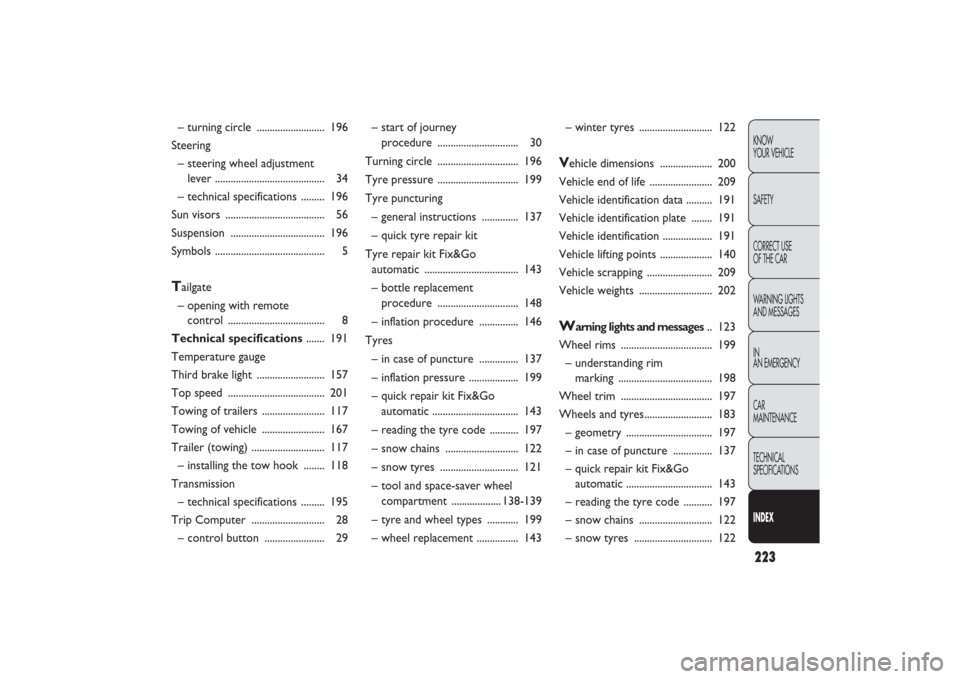
223KNOW
YOUR VEHICLE
SAFETY
CORRECT USE
OF THE CAR
WARNING LIGHTS
AND MESSAGES
IN
AN EMERGENCY
CAR
MAINTENANCE
TECHNICAL
SPECIFICATIONSINDEX
– turning circle .......................... 196
Steering
– steering wheel adjustment
lever .......................................... 34
– technical specifications ......... 196
Sun visors ...................................... 56
Suspension .................................... 196
Symbols .......................................... 5Tailgate
– opening with remote
control ..................................... 8
Technical specifications....... 191
Temperature gauge
Third brake light .......................... 157
Top speed ..................................... 201
Towing of trailers ........................ 117
Towing of vehicle ........................ 167
Trailer (towing) ............................ 117
– installing the tow hook ........ 118
Transmission
– technical specifications ......... 195
Trip Computer ............................ 28
– control button ....................... 29– start of journey
procedure ............................... 30
Turning circle ............................... 196
Tyre pressure ............................... 199
Tyre puncturing
– general instructions .............. 137
– quick tyre repair kit
Tyre repair kit Fix&Go
automatic .................................... 143
– bottle replacement
procedure ............................... 148
– inflation procedure ............... 146
Tyres
– in case of puncture ............... 137
– inflation pressure ................... 199
– quick repair kit Fix&Go
automatic ................................. 143
– reading the tyre code ........... 197
– snow chains ............................ 122
– snow tyres .............................. 121
– tool and space-saver wheel
compartment ................... 138-139
– tyre and wheel types ............ 199
– wheel replacement ................ 143– winter tyres ............................ 122
Vehicle dimensions .................... 200
Vehicle end of life ........................ 209
Vehicle identification data .......... 191
Vehicle identification plate ........ 191
Vehicle identification ................... 191
Vehicle lifting points .................... 140
Vehicle scrapping ......................... 209
Vehicle weights ............................ 202W
arning lights and messages
.. 123
Wheel rims ................................... 199
– understanding rim
marking .................................... 198
Wheel trim ................................... 197
Wheels and tyres.......................... 183
– geometry ................................. 197
– in case of puncture ............... 137
– quick repair kit Fix&Go
automatic ................................. 143
– reading the tyre code ........... 197
– snow chains ............................ 122
– snow tyres .............................. 122
215-224 PANDA EN 7-10-2009 15:09 Pagina 223